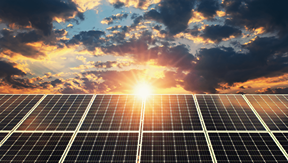In our previous blogs we have discussed the united efforts that we must undertake to ensure we reverse climate damage. So, it is unsurprising that all responsible companies in many different sectors are considering the efforts they can make to do their part for the planet.
The sustainable energy sector is no exception and as technology has been improving in recent years, it will be interesting to learn and watch how these technological improvements can support the energy sector, especially with its focus on cleaner, renewable energy. As well as understanding what is required to make necessary changes. In this article we will explore what we can expect to see with these new technologies and how this will impact the industry.
Solar Energy
Solar energy has proven to be an increasingly popular method that uses natural resources to create energy. The demand for the resource is continuing to grow, as homeowners are installing panels on their properties. In the UK it was reported that there was a 400% increase in commercial enquires for the manufacturing sector during 2022. As energy bills have recently soared, this has likely increased the popularity of solar energy as well as the need for cleaner methods.
But why stop there, why not consider solar powered transportation? This is exactly what has taken place in Australia, The Aldershot train is the first 100% solar powered train, over 70 years old it is used as a tourist attraction in New South Wales, Australia. In 2017 the train was refurbished, and solar panels were installed on the roof of the train to cover the 3km journey between the North Beach and Byron Beach stations, at a leisurely 18km/h speed.
Trains require a large amount of energy to make them move, so for electric trains to run, many panels would be required to allow the train to operate at adequate speeds. We are a while off from wide-spread solar powered transportation vehicles; however, this is an example of what can be possible, especially as technology continues to develop.
With an increased installation of solar panels, this reduces the amount of fossil fuels required and therefore decreasing the levels of carbon dioxide and other greenhouse gas emissions. Solar is also a renewable energy, unlike fossil fuels, so we aren’t relying on a limited amount of the resource, which means in the long run it is a more sustainable resource and worth investing in.

Bladeless Wind Energy
Traditionally wind turbines are designed with blades that rotate in the wind, which in turn spins a generator that creates energy. This is another example of a method that uses natural resources to create clean electricity.
A downside to wind turbines is that they rely on the wind to rotate the blades, without it then the turbines cannot generate electricity. So, it would be extremely useful for these machines to able to create energy all year round. This is an invention that Vortex Bladeless, a Spanish start-up has come up with to work around that issue. An elastic rod is used to secure the 3m tall bladeless turbine, vertically into the ground. When wind passes the structure, a vortex of pressure is created. Depending on the speed of the wind, the frequency of the vortexes will vary. When the structure begins to sway or oscillate then it can generate energy. The benefit of this invention is it does not rely on the same volume of space required for conventional wind farms, meaning it can be used in both urban and residential areas.
Food Waste Solar Panels
We have already discussed the existing solar panels; however, a new addition has been recently invented by Carvey Ehren Maigue, who won the James Dyson Foundation Sustainability Award in 2022 for panels he constructed.
These panels are different to traditional panels as they do not need direct sunlight. The panels are made from food waste, the particles inside the liquid absorb the sun’s ultraviolet (UV) rays and turn them into visible light. The panels are then able to convert this harvested light into electricity. UV rays can reach us on cloudy days, so there is a lot more potential for this product in urban areas and other locations where a typical solar panel could not be placed.
While this is in the early stages of experimentation and there is not currently a product like this on the market, the concept is extremely fascinating. This would undoubtedly save tonnes of food scraps going to waste and repurposing it into something new.

Lithium-Glass Batteries
This is a type of solid-state battery, using glass electrolyte and lithium or sodium metal electrodes.
These batteries have a much longer lifespan compared to conventional batteries. They can function at lower temperatures, charge faster, cheaper and are safer, all whilst storing more energy over time.
The use of re-useable batteries limits the need for single use batteries and reduces the volume being sent to landfill. They are also recyclable, so consumers and companies should do their part to reuse the minerals that are already in production before new minerals are mined.
Conclusion
It is clear to see there are many ways in which technology is influencing the sustainable energy sector and how we can move towards a green, cleaner future. It is imperative for the planet and life on this planet that we make these better choices and reduce the emissions and therefore the impact this has on the environment.
We hope you found this week’s blog interesting. Let us know your thoughts on how technology may impact the energy sector! If you enjoyed the blog, then why not share, and make sure you’re subscribed so you can gain early access!

